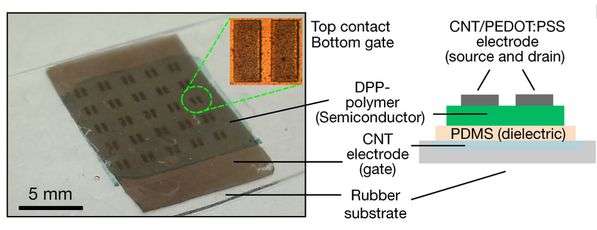November 17, 2016 report
A non-covalent-bonding method for making organic semiconductors that are stretchable and healable

(Phys.org)—A large team of researchers from the U.S., Japan and South Korea has developed a non-covalent-bonding method to produce high-performance organic semiconductors that are stretchable and healable. In their paper published in the journal Nature, the researchers describe the transistors they made and the results they found when exposing them to twisting and stretching. Siegfried Bauer and Martin Kaltenbrunner with Johannes Kepler University in Austria offer a News & Views piece on the work done by the researchers and provide some insights into the hurdles still facing material science engineers seeking to make such products ready for use in the real world.
One of the goals of engineers working on electronics of the future is to mimic the abilities of living organisms—to make devices that can be turned, twisted and stretched while continuing to function properly—traits similar in many respects to human skin. A bonus would be a material that could also self-heal. In this new effort, the researchers have developed a technique for using polymers as the basis for creating a stretchable material suitable for use in creating electronic devices which can also be healed using heat.
As Bauer and Kaltenbrunner note, researchers have used three major strategies for incorporating electronics into stretchable materials—placing rigid materials on small islands inside of rubbery materials, laminating foils which wrinkle and un-wrinkle on demand and using materials that are stretchy at the molecular level. The researchers with this new effort have taken this third approach—they created a conjugated polymer that incorporates non-covalent interactions between chains. The result was a material that was not only able retain its electrical performance after 500 stretching cycles but could be repaired when eventually cracked by placing it in a steam chamber for half an hour. The group also tested several transistors they created with the material by applying them to their hands and forearms—they report that under normal bending and twisting movements, the devices continued to perform normally.
While the material does represent progress toward the ultimate goal, Bauer and Kaltenbrunner point out there is still more to do—heating the material to 150°C to heal it, for example, is not really viable for a patch applied to a person's skin. Also, the voltage required to run the transistors was still too high to be practical for a wearable device.
More information: Jin Young Oh et al. Intrinsically stretchable and healable semiconducting polymer for organic transistors, Nature (2016). DOI: 10.1038/nature20102
Abstract
Thin-film field-effect transistors are essential elements of stretchable electronic devices for wearable electronics. All of the materials and components of such transistors need to be stretchable and mechanically robust3, 4. Although there has been recent progress towards stretchable conductors, the realization of stretchable semiconductors has focused mainly on strain-accommodating engineering of materials, or blending of nanofibres or nanowires into elastomers. An alternative approach relies on using semiconductors that are intrinsically stretchable, so that they can be fabricated using standard processing methods. Molecular stretchability can be enhanced when conjugated polymers, containing modified side-chains and segmented backbones, are infused with more flexible molecular building blocks. Here we present a design concept for stretchable semiconducting polymers, which involves introducing chemical moieties to promote dynamic non-covalent crosslinking of the conjugated polymers. These non-covalent crosslinking moieties are able to undergo an energy dissipation mechanism through breakage of bonds when strain is applied, while retaining high charge transport abilities. As a result, our polymer is able to recover its high field-effect mobility performance (more than 1 square centimetre per volt per second) even after a hundred cycles at 100 per cent applied strain. Organic thin-film field-effect transistors fabricated from these materials exhibited mobility as high as 1.3 square centimetres per volt per second and a high on/off current ratio exceeding a million. The field-effect mobility remained as high as 1.12 square centimetres per volt per second at 100 per cent strain along the direction perpendicular to the strain. The field-effect mobility of damaged devices can be almost fully recovered after a solvent and thermal healing treatment. Finally, we successfully fabricated a skin-inspired stretchable organic transistor operating under deformations that might be expected in a wearable device.
Journal information: Nature
© 2016 Phys.org




















